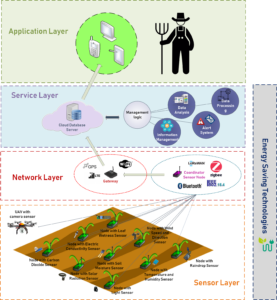Remote Sensing Monitoring Systems
The future of precision agriculture lies upon modern technological advancements and remote sensing techniques using Unmanned Aerial Vehicles (UAV) and different kind of smart sensors. Sensors and UAVs are a part of the Internet of Things (IoT) paradigm.
The IoT is a modern communication network involving the employment of a vast number of distributed smart devices around a unified wide area network. Its basic characteristic stands upon the ability to recognize and notify users instantly about real-time events by the use of smart objects.
The adoption of smart farming though is hampered because of the lack of models providing guidance to practitioners regarding the necessary components that constitute IoT-based monitoring systems.
A precision agriculture monitoring system consists mainly of the sensing agricultural parameters, the identification of sensing location and data gathering, the routing of data from crop field to control station for decision making, the actuation and control decision based on sensed data and the visualization of results to the grower through an application.

In precision agriculture WSN communication protocols and technologies are used to support the connection between sensor nodes in the network and to provide a channel for communication between the coordinator node and the gateway. According to the type of application, such as precision farming, field irrigation management or greenhouse crop management, the sensor network topology and communication demands may differ.
The basic goal is to build each smart monitoring system upon application appropriate networking technologies to operate efficiently with minimum energy consumption. Once the coordinator node obtains the data it forwards the flow of information to the gateway to reach the main server, where the database is located.
As a next step, choosing the most appropriate device management technology depends on software and hardware specifications, network and technology architecture and communication standards being used in the according system to achieve maximum and efficient performance. In the view of using different kind of smart entities in an agriculture monitoring system, the services of this architectural layer facilitate the desired interoperability of the technologies introduced. All collected data will be stored on a remote server and transmitted to the client machine through Application Programming Interfaces (APIs) that provide web services for third-party users. APIs enable device communication in an application level for different kinds of purposes and are based on different architectures to transfer data from the server to the client.
In a smart farming monitoring system, the basic component of intelligence is considered to be the study and filtering of the collected data. The use of Earth Observation techniques enable the advance of cultivation procedures and increase productivity by providing the base layer for spatial information analysis and monitoring of agricultural activities. A large percentage of smart agriculture applications are based on simulators, commercial programs and specific programming languages for implementing and controlling the data system.
Information management is deployed so the farmer can consult, record and modify the information collected by the sensors in tables, statistical graphs and interactive maps. In addition, it can download daily, monthly and annual reports of historical data. However, the farmer can mainly see the current data of the monitored variables of one or all the WSN nodes and consult the history.
Based on a precision agriculture monitoring system, the farmer can interact with the IoT applications of the system to remotely manage the cultivation process. Such applications may concern any aspect of the agricultural field ranging from planting and irrigation processes to plant protection and harvesting methods. The applications that can be adopted may involve the fertilizer application, the weed mapping, the spraying process, the irrigation of the field and the alert system.
This blog post is part of the paper Precision Agriculture: A Remote Sensing Monitoring System Architecture. Triantafyllou, A.; Sarigiannidis, P.; Bibi, S. Information 2019, 10, 348. https://doi.org/10.3390/info10110348